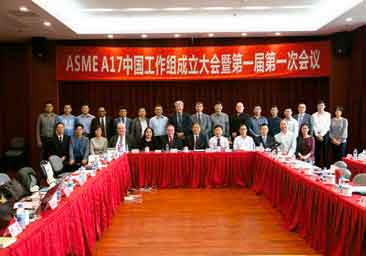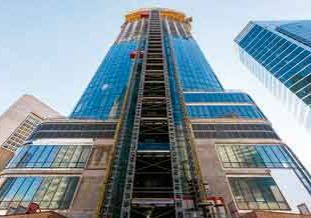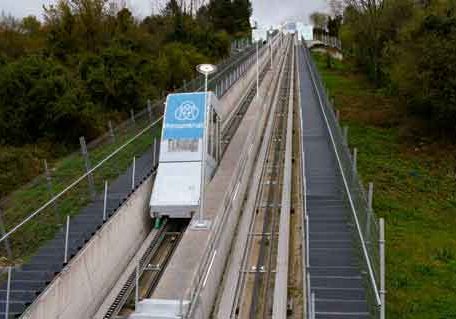Inauguration of ASME A17 Committee Marks Milestone for China
Oct 1, 2018

A report on ASME’s recent trip to China
For the last decade, the explosive growth of elevator and escalator construction in China has been remarkable, huge, and other adjectives to describe, “Holy cow, that’s big!” The numbers of new units, as reported by Hitachi,[1] have the number of major company elevator sales between 2008 and 2015 at 297,000 units! 2016 and 2017 showed minor decreases of 3% to 5%, adding another 100,000 units. Amazingly, this brings their total number of installed units to over 5 million. By comparison, in the U.S. and Canada, there are approximately 1.1 million units.
The largest reason for this staggering growth was the need for housing the hundreds of millions of Chinese flocking to work in new factories, as orders from around the world demanded manufacturing production in vast quantities. In terms of population, cities and their environs in China can exceed 30 million people! New buildings for housing, and also new supertall buildings for office space, are going up by the thousands.
With this amount of growth in this amount of time, several logistics problems quickly become evident: shortages of labor to manufacture and install, then labor to maintain them and labor to inspect and test them. Once labor is available, training is required. Then, training the trainers is necessary. Where, here in the U.S. and Canada we require four years of experience before we put someone out as a mechanic or as an Authority Having Jurisdiction Certified Elevator Inspector, the numbers of trainers could not catch up to the feverous rate of the needs.
All the shortages began leading to incidents of injury, causing notice at the highest levels of the Chinese government. In 2014, resolutions to these issues were detailed in a national law.
Law on the Safety of Special Equipment of the People’s Republic of China
“Article 1. This law is formulated to strengthen safety supervision of special equipment, prevent and reduce special- equipment accidents, protect personal and property safety and promote social and economic development.
“Article 2. Special equipment production (including design, manufacture, installation, alteration, maintenance and repair) operation, use, inspection and testing as well as special- equipment safety supervision and management shall apply to this law.
“As used in this law, the term “special equipment” refers to boilers, pressure vessels (including gas cylinders), pressure pipelines, elevators, lifting appliances, passenger ropeways, large-scale amusement facilities and field (plant) special-purpose motor vehicles, which have high risks relating to safety of human lives and properties, as well as other special equipment in conformity with this law stipulated by laws and administrative regulations.
“The state implements cataloged management of special equipment. The catalog for special equipment shall be drawn up by the department in charge of special-equipment safety supervision and management of the State Council and shall be subject to approval by the State Council before its implementation.
“Article 22. Elevator installation, alteration and repair must be carried out by the elevator manufacturer or an entity commissioned by the manufacturer that has obtained the relevant license according to law. Elevator manufacturers that entrust other entities to conduct installation, alteration and repair shall have safety guidance and supervision for the installation, alteration and repair and shall conduct verification and testing in accordance with safety technical code. Elevator manufacturers shall be responsible for the safety performance of the elevator.
“Article 101. This law shall come into force on January 1, 2014.”
Chinese delegations have visited elevator industry safety groups around the world, here in the U.S. and Canada visiting the National Association of Elevator Safety Authorities (NAESA International), the City of New York’s Department of Buildings, the American Society of Mechanical Engineers (ASME) leadership and A17 Standards Committee to learn how we maintain and inspect our units.
After more than 10 years of official visits and many conversations, a new milestone occurred on May 5 and 6, 2018. After months of discussions, the ASME A17 Chinese International Working Group (CIWG) was formed and had their inaugural meeting in Shanghai before the 2018 Shanghai World Elevator & Escalator (WEE) Expo. The members of the ASME delegation were treated as dignitaries at the WEE opening ceremonies.
This delegation consisted of ASME A17 Standards Committee Chairman Jim Coaker; A17 Secretary Geraldine Burdeshaw; A17 Standards Committee members John Koshak (also president of the International Association of Elevator Consultants), Patrick Bothwell (from EHC) and David McColl (from Otis Elevator Canada); inspectors from Alberta, Canada; Alberta Elevating Devices & Amusement Rides Safety Association (AEDARSA) CEO Gord Pattison; AEDARSA VP of operations, Safety Services Dean McKernon; and from New York City, the Director of Elevators Harry Vyas and Assistant Commissioner, Central Inspections Dmitri Dits. We were all invited by the Shanghai Institute of Special Equipment Inspection and Technical Research, the safety authority selected to regulate elevator and escalator Safety in China. Keeping the delegation well managed and informed was Leona Fu, manager of Operations, ASME Beijing Office, who escorted us, answered questions and acted as translator when needed.
The original 19 members of the CIWG were appointed and the first chairman of the newly formed ASME Committee was Shen Gongtian of the China Special Equipment Inspection and Research Institute and Vice Chairs Xia Long of the Special Equipment Safety Supervision Administration Bureau of State Administration for Market Regulation and Liang Guangchi of the Shenzhen Institute of Special Equipment Inspection and Test. Qian Jianxiong is the Committee Secretary representing China Special Equipment Supervision and Inspection Institute.
According to ASME,
“The A17 China International Working Group serves as a subordinate group operating within the Charter of the A17 Elevators and Escalators Standards Committee and scope of the A17 series of standards. The A17 China IWG provides for the participation in A17 development by technical expert members based in China. The A17 China International Working Group will:
- Initiate and process proposed standards actions for eventual consideration by the A17 Standards Committee.
- Review and provide comments on proposed revisions to all A17 Standards and QEI-1.
- Conduct technical and administrative activities related to all A17 Standards and QEI-1 development in accordance with approved ASME procedures, policies, and established guidelines.
- Coordinate IWG activities with its parent committee and ASME staff.”
The ASME delegates were also honored to be considered special guests at the opening ceremony of the WEE Expo on May 7, 2018.
The fact that China has taken this important step is a recognition of several things.
First, the number and notoriety of incidents in China has motivated a change in maintenance and inspection practices. There has been a growing concern that inspections have not been as thorough as they are here in the U.S. and Canada. Clearly, there was not an adequate number of inspectors or quality of inspections. The change by China to improve is very evident.
Second, the only code or standard in the world that incorporates maintenance and inspection requirements is ASME A17.1/CSA B44. The use of A17.1/B44 as the guiding document going forward is in response the Special Law recently enacted by the Chinese government requiring mandatory maintenance and inspection. The thoroughness of A17.1/B44 Part 8 is well established and of the most interest to the Chinese committee.
Third, it is the culmination of implementing the Law on Safety of Special Equipment, which went into effect on January 1, 2014 (ELEVATOR WORLD, May 2016).
The application of ASME A17.1/CSA B44 in China is a great step forward for safety, and the new ASME A17 China IWG sets a course that will change Chinese elevator-industry safety forever.
References
[1] Hitachi Review Vol. 66 (2017), No 3, Hanging, Wu, et al.
[2] ELEVATOR WORLD 2017 Global Statistics Report.
Get more of Elevator World. Sign up for our free e-newsletter.









